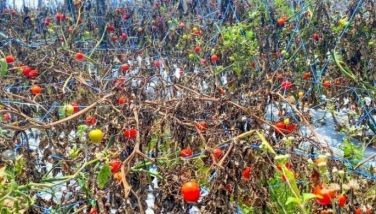Tree Of The Month (PART 1): Almaciga - Agathis philippinensis
Physical Characteristics
The almaciga is a very large tree, reaching 300 centimeters in diameter at breast height and 60 meters in height.
The trunk is straight, cylindrical, or may taper and sometimes with markedly spiral grain. It has no buttress but with big, swollen, superficial roots. The crown is narrow. The branches are radial, or like rays spreading from the trunk, and may droop or turn at the ends and vary in thickness. The bark is smooth, gray, and one to 1.5 centimeters thick, peels or sheds off in large irregular plates, and is a rich source of resin.
The young leaves are about three to four centimeters wide and at least 10 centimeters long. Leaves from fully-exposed branches are rounded at the apex, and measures four to five centimeters long and 1.5 to two centimeters wide.
Cones are spherical and about eight centimeters in diameter. Male cones are borne in or slightly above the leaf axils and cylindrical cone scales are shield-like in appearance, numerous, and with 10 to 12 pollen sacs.
Female cones are situated at the tip, are either egg- or ball-shaped, with numerous woody cone scales, each bearing a single large ovule. The cones become massive and woody at maturity, with viable seeds forming only at the center of the cone. The seeds are egg-shaped and flattened with one large wing. Sometimes the wings are smaller than usual. Ripe cones shatter on the tree.
Distribution
Almaciga is present in primary forests at medium and high altitudes from the Babuyan Islands and Northern Luzon to Palawan and Mindanao.
Methods of Propagation
This tree is usually propagated by seeds, which have low viability. Stand establishment is normally through natural regeneration, planting stock, and wildlings.
Contemporary Use
This tree is much in demand as a chief source of Manila copal and for its high-quality timber used for many general purposes. It is planted as an enrichment crop in inadequately stocked areas or under-planted in existing plantations, as it needs partial shade in the early stages of its development.
Traditional Use
Locally, almaciga is employed as incense in religious ceremonies and for torches, to start fires, for caulking boats, and as smudge for mosquitoes. It is exported in considerable quantities, chiefly for use in the manufacture of high-grade varnish, but also for other processes, such as making patent leather and sealing wax. Almaciga is suitable for the manufacture of cheap soaps and paper sizing. In Malaya, the resin is used as a liniment. The sap is used as himughat (medicine against bughat, a condition in which a patient falls back to illness after apparent recovery).
How to plantyour almaciga seedling
Clear the area where you want to plant your seedling with unwanted weeds and debris. Make sure that a one-meter radius is kept free from other vegetation. Dig a plant hole with dimensions of at least 20 cm x 20 cm x 20 cm. Plant the seedling at proper depth. Root collar should be at level with or a little below the ground surface, with the seedling oriented upward. Fill the hole with top or garden soil and press soil firmly around the base of the seedling. In plantation-making, maintain a two-meter distance between seedlings if they are planted in a row of a three-meter distance from one strip to the next strip.
How to take care of your almaciga seedling
Remove grass and other unwanted vegetation and cultivate the soil around the base of the seedling (50-centimeter radius) once in every quarter for two to three years. Place mulch around the base of the seedling (maintaining the 50-centimeter radius and using cut grass, leaves, and other suitable materials as mulch base).
Prune the branches at most 50 percent of the crown depth, preferably during dry season, and ensure that when pruning you do not injure the bark. Remove infected or infested vegetation nearby to stop plant diseases from spreading and contaminating your seedling. Monitor regularly the growth of the seedling for presence of pests and diseases.
Data about native tree species are featured by the Ramon Aboitiz Foundation Inc. For comments and suggestions, e-mail [email protected].
- Latest


























